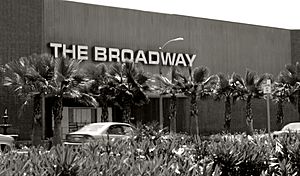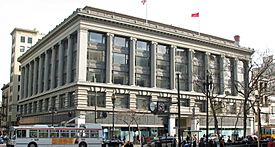Broadway Stores facts for kids

A former The Broadway department store at the Hawthorne Plaza Shopping Center in Hawthorne, California, in 2010
|
|
|
Formerly
|
|
|---|---|
| Public | |
| Traded as | NYSE: BWY |
| Industry | Retail |
| Fate | Company was sold to Federated Department Stores |
| Successor | Macy's |
| Founded | February 24, 1896 as The Broadway in Los Angeles |
| Founder | Arthur Letts, Sr. |
| Defunct | October 12, 1995 |
| Headquarters |
,
US
|
|
Area served
|
United States |
|
Key people
|
Edward W. Carter, Prentis C. Hale, Philip M. Hawley |
| Divisions |
|
Broadway Stores, Inc. was a large American company that owned many department stores. It was based in Southern California. Over the years, it was known by different names, including Carter Hawley Hale Stores. The company grew by buying other store chains across the United States. It became a big retailer in the 1970s and 1980s. Even after facing attempts by other companies to buy it in the 1980s and needing financial help in 1991, it kept going. However, in August 1995, its banks stopped giving it enough money to pay suppliers. So, the company was sold to Federated Department Stores for $1.6 billion. The sale was completed on October 12, 1995.
Contents
History of Broadway Stores
How It All Started
In 1950, the city of Los Angeles was growing very fast. A popular department store there, The Broadway, which started in 1896, joined with another company called Hale Bros. Stores, Inc.. The new company was named Broadway-Hale Stores. Edward W. Carter, who was the president of The Broadway, became the president of this new, bigger company.
The company quickly started to expand. Broadway stores opened in San Diego in 1961 and Phoenix, Arizona, in 1968. In 1970, the company bought Emporium-Capwell Co. This company owned two well-known stores in the San Francisco Bay Area: Emporium and Capwell's. Broadway-Hale kept their original names.
Around the same time, in 1969, Broadway-Hale also bought Neiman Marcus, a fancy department store, and Waldenbooks, a bookstore chain. They worked hard to make these businesses grow all over the country.
Changes in the 1970s and 1980s
In 1972, Prentis Hale retired. Edward Carter became the chairman, and Philip M. Hawley became the company president. In 1974, the company changed its name to Carter Hawley Hale Stores, Inc. This new name was a bit long and hard to say!
The company kept buying more stores. In 1972, they bought Bergdorf Goodman in New York and Holt Renfrew in Canada. After trying to buy Marshall Field in 1977, they bought John Wanamaker's in Philadelphia in 1978. They also bought Thalhimers in Virginia. In 1980, Emporium and Capwell's stores in the San Francisco Bay Area joined to become Emporium-Capwell. Weinstock's stores expanded into Utah and Nevada. The Broadway stores also grew into Colorado, New Mexico, and Nevada. Even though sales went up, the company wasn't making as much profit as it should.
To try and fix things, Carter Hawley Hale decided to sell off some of its businesses. They sold Waldenbooks in 1985 and Wanamaker's in 1987. They also separated their luxury stores like Neiman-Marcus and Bergdorf Goodman into a new company called Neiman-Marcus Group, Inc.
The Final Years in the 1990s
By 1991, Carter Hawley Hale Stores was facing serious financial problems. It had become the sixth-largest department store chain in the U States in 1984, but then struggled. Part of the problem was strong competition from other stores like Nordstrom. The company had to get special financial help to reorganize its business.
In 1992, a businessman named Sam Zell helped the company get back on track. He took a large ownership stake in the newly renamed Broadway Stores, Inc.. The company officially came out of its financial difficulties in October 1992. Philip Hawley, the CEO, then announced his retirement. In early 1993, three Weinstock's stores in Utah were closed.
After Sam Zell took over, David Dworkin became the new CEO. He tried to save money by updating stores and making operations more efficient. In June 1994, the company officially changed its name to Broadway Stores, Inc. to show a fresh start. But it was too late.
The end came on August 8, 1995. The company's lenders said they would not give them any more money. This money was needed to buy new products for the stores. A week later, the company announced it would be sold to Federated Department Stores. The sale was completed on October 12, 1995.
After the sale, Federated Department Stores combined the former Broadway, Emporium, and Weinstock's stores with its own Macy's and Bullock's chains. This created a new division called Macy's West. Some stores that were too close to each other were sold or closed. Federated also used some of the old Broadway store locations to open its fancy Bloomingdale's stores on the West Coast.
Today, some of the old buildings still stand. For example, the former Emporium-Capwell store in San Francisco was turned into another Bloomingdale's. The old company offices in Los Angeles were even turned into a hotel called "The Standard."
Main Store Divisions
The Broadway
The Broadway was the biggest part of the company. It started as The Broadway Department Store in Los Angeles in 1896. By 1992, it had grown across Southern California and even outside the state. At one point, it was split into two divisions: Broadway Southwest for out-of-state stores and Broadway Southern California for stores in California. These two parts were combined again in 1992. When the company was bought by Federated, Broadway had 52 stores.
Hale's
The Hale's chain began in Sacramento, California, in 1880. It was started by the Hale Brothers. By 1949, the company had bought its rival, Weinstock, Lubin & Co.. Weinstock's stayed a separate brand. Later, the Hale's stores in Northern California became part of the Weinstock's brand.
Emporium-Capwell
Emporium-Capwell was formed in 1927 when two companies, the San Francisco-based Emporium and the Oakland-based H.C. Capwell Company, merged. They kept the two store names separate for a while. By the time Broadway-Hale bought them in 1970, they had many Emporium and Capwell stores in the San Francisco Bay Area. In 1980, the two brands were combined to form a single Emporium-Capwell brand. There were 22 Emporium-Capwell stores when the company was bought by Federated.
Weinstock's
Weinstock's stores started in Sacramento, California. There were 8 Weinstock's stores left when the company was bought by Federated.
Advertising
For many years, the company used famous slogans in its ads. On radio and TV, they would say, "It's at the Broadway." Another popular slogan was, "The Broadway is Southern California." A deep male voice would say these slogans in their commercials.


